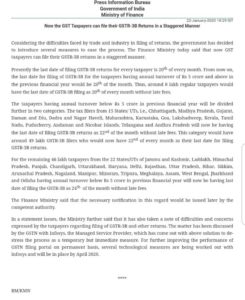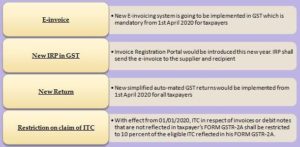 First 15 features (1-15 points) as PART-I:-
First 15 features (1-15 points) as PART-I:-
- Supplier can upload the Tax Invoices on real time basis in Anx-1.
- Recipient can view his purchase Invoices on near real time basis.
- Recipient can also view whether supplier has filed his return or not.
- Supplier has to upload the Tax Invoices latest by 10th of Next Month.
- However, recipient can claim ITC on missing invoices also subject to certain conditions.
- In case, Invoice uploaded by the supplier in Anx-1, but RET-1 is not filed, uploading of invoices in Anx-1 will be treated as self-admitted liability and recovery proceedings will be initiated against the supplier, except in certain specified situations where recipient will be liable to pay.
- Recipient has to pay the amount of ITC availed on missing invoices after specified period. (Missing invoices means, invoices not uploaded in Anx-1)
- To find out missing invoices, Offline IT Tool will be provided for matching invoices in Anx-2 with invoices in the accounting system of recipient.
- Payment of tax shall be discharged full at the time of filing of RET-1 or SAHAJ or SUGAM itself.
- In case of Quarterly returns, tax shall be paid on monthly basis.
- Recipient can do the following actions on the invoices appearing in Anx-2 (auto drafted Purchase Invoice):
Accept also called as locking
Reject (eg. Invoice not related to the recipient)
Pending
- If no action is taken on a particular invoice, it will be deemed by the system as accepted and ITC will be available against these invoices.
- Once invoice is accepted by the recipient, i.e., locked by the recipient, supplier cannot amend those invoices.
- Locked Invoice should be unlocked by the recipient only, for making any amendment by the supplier.
- Supplier will be able to issue Debit Note or Credit Note on locked invoices also. If credit/debit note is issued against any pending invoice, then system will club the credit/debit note with pending invoice.
Second set of 15 features (16-30 points) as PART-II:-
- Missing invoices shall be reported in RET-1 of the current month.
- System will calculate the interest automatically. Once the tax and interest is paid, the missing invoice will be clubbed with the monthly return to which it relates.
- For amendments, separate Return Form is available.
- Maximum 2 amendments return can be filed for any one month.
- “NIL” Return can be filed by “SMS”.
- Negative liability if any shall be carried forward to next month regular return.
- Higher late fee for amendment return if change in liability is more than 10%
- Shipping Bill details also should be entered in Anx-1 by the exporters.
- If the shipping bill details are not available by the time of filing the return, the same can be entered later on also.
- The export data then will be transmitted to ICEGATE portal for cross verification purposes.
- Until the facility is ready to pull the data from ICEGATE portal, importers can avail ITC on imports and supplies from SEZ on self-declaration basis.
- New concept of suspension of registration will be introduced. From the date of suspension till the date of cancellation, tax payer need not file returns and invoice uploading also will not be allowed.
- HSN should be reported at 4 digit level in monthly return.
- The tables in the return will be opened based on the profile of the tax payer.
- For all return obligations offline utility tools are made available to make filing process as easy as possible.
 As part of Government of India’s Ease of Doing Business (EODB) initiatives, the Ministry of Corporate Affairs would be shortly notifying & deploying a new Web Form christened ‘SPICe+’ (pronounced ‘SPICe Plus’) replacing the existing SPICe form.
As part of Government of India’s Ease of Doing Business (EODB) initiatives, the Ministry of Corporate Affairs would be shortly notifying & deploying a new Web Form christened ‘SPICe+’ (pronounced ‘SPICe Plus’) replacing the existing SPICe form.




